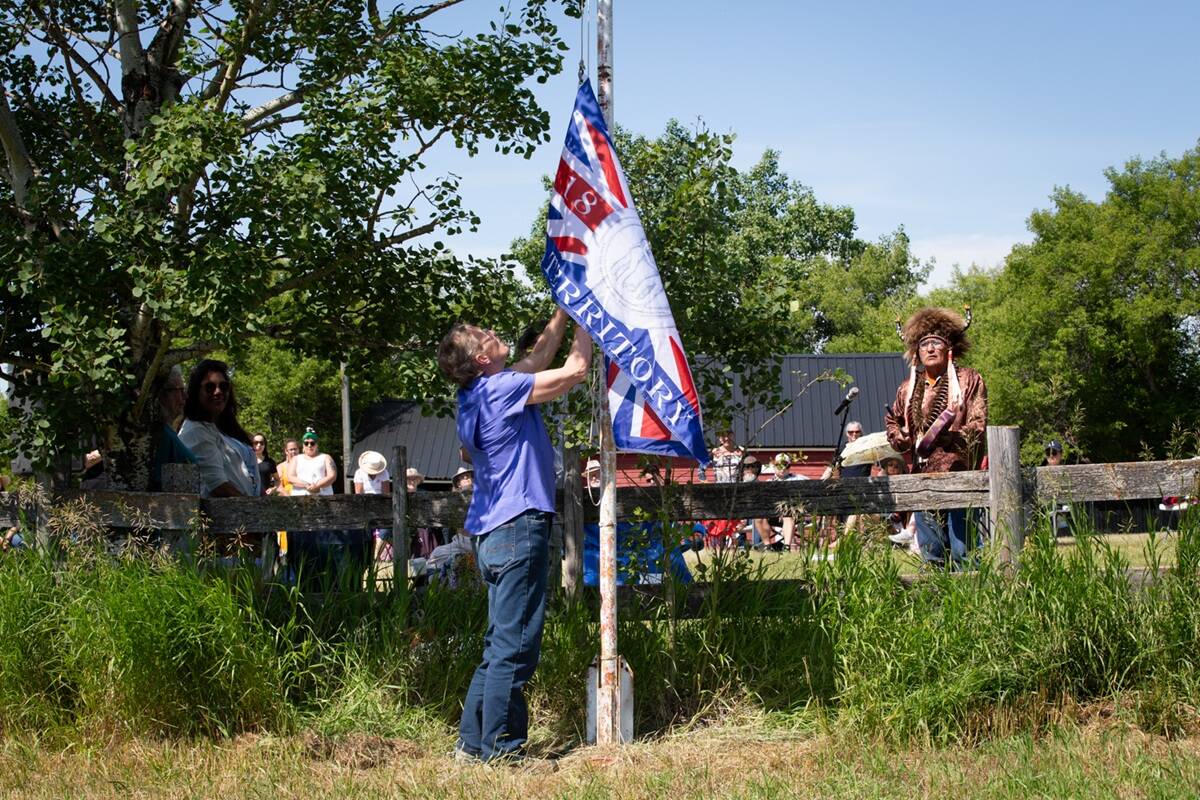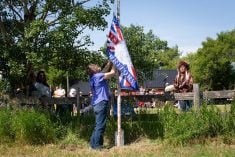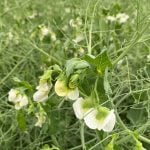Talk to anyone at a branding and they’ll tell you they come out to help because it’s fun — it’s work that has to be done — but it’s still fun. The underlying message is that even though farms and ranches keep getting larger and distances between them keep getting wider, you don’t have to go it alone.
Lloyd and Jean Thompson of T Four Ranches, near Carnduff, Sask., had their first branding about six years ago. As it stands, they have no intention of going back to the old chute days when they processed calves in the fall. Thompson easily rattles off a list of reasons why spring branding is working out better than fall processing on their ranch. “In the fall it’s tougher to get a crew, the calves are bigger so it’s harder on the people, there’s more stress on the calves when you dehorn and castrate at that age and the vaccines don’t do as much good. A branding in the spring is easier on the calves and on the people — everyone but Jeannie, because she does all of the cooking. At the same time, the social aspect offsets that, too,” Thompson says.
Read Also

Treaty Land Sharing Network expands reach in Saskatchewan and Alberta
The Treaty Land Sharing Network, which connects land holders with First Nations and Metis people, has expanded since it began in 2018
Calving starts April 20, so they aim to have their brandings in the middle of June before the cows start into their summer rotations. With help from their son-in-law, Scott, and daughter, Barbara, they run 600 pairs in three groups — two near the home place and another about 25 miles away. They also retain all of their calves and grass them as yearlings. In total, the ranch encompasses 10,000 acres of pasture and hayland.
A “branding” is a fairly broad term considering the work that gets done in a day. Without bars and panels in the way, it takes the crew only a minute or so to vaccinate, tag, brand and, if necessary, castrate and dehorn a calf, then it’s up and on its way. The main requirements are to have enough riders who are good with a rope to keep pulling the calves through and a ground crew capable of getting the rest of the work done in short order.
Thompson lines up the main crew to make sure all of the jobs are covered off and they often show up with friends and neighbours — sometimes experienced riders who enjoy the outing, or new people who are just learning the skills. Then Thompson owes them a day in return. Whether it’s at their branding or doing other jobs, he knows they will call when they need the extra hand.
The day begins with sorting off the calves. They have permanent corrals available at all three locations, but he has seen portable panels work just as well, too. It’s all in how it’s arranged, he says. He sets it up so that the holding area for the calves is on the same side of the corral as the cows outside the gate. When a calf is pulled out of the group, the others are curious and sometimes want to follow along. They are more apt to stay in the holding area when the mama cows are next to them. As a double stop — in the inevitable event that a calf does escape — he arranges it so the calves stay in an open area of the branding corral near the cows until the branding is finished. Having to ride out among the cows to bring in an escapee really disrupts the crew, he adds.
The calves receive two vaccines — a 7-way with Somnugen and a 5-way for IBR and pneumonias. Each of the two people doing the needling mark the calf with a different colour when they administer the vaccine so there’s no chance that an animal could be missed or double vaccinated. Dehorning is done with a hot circle iron applied around the base of each horn. Castration is by knife. Done properly, there’s no bleeding, very little chance of complications and you know for sure that the job is done.
When everything moves along according to plan, a crew can process 75 to 100 calves in an hour.
“We’ve been needling the cows for their diseases forever and it seems like when we get the baby calves needled in the spring it helps them for the rest of their lives,” Thompson says. They may boost the calves again in the fall, depending upon the year and circumstances, and they always get a booster in the spring.
GRAZING SYSTEM
Turnout is another annual event that has fallen by the wayside in recent years.
The calves are wintered together in the yard in one 80-acre pen. When the wet spring storms start to roll in, he lets them move out onto a clean quarter section with windbreaks for shelter and feed provided. They can drift back into the yard for water, but letting them out into the big pasture keeps them clean and helps to spread some of the litter around to fertilize the grass. They just start eating the fresh grass in the carry-over as they go.
The Thompson’s yard is set up with typical feedlot pens and a silo for feeding silage-based rations. Switching to hay and wintering them as one group in the big pen didn’t seem like too much of an adjustment — it was letting them out onto the quarter section that took some getting used to, he recalls.
“We probably looked for more gain when we used to keep them up tight and feed silage. With grain getting more reasonable in price, we may rethink that again, but this works extremely well. That tinge of new grass does wonders. We can see that they slick off earlier and start to gain more quickly on grass,” he says. “You need that sharp pencil, but the sharp pencil and what you are comfortable doing don’t always agree.”
They pasture the yearlings in three groups — steers, heifers and replacement heifers — trailing them to the best pastures of high-quality meadow bromealfalfa pastures just as soon as the grass is ready to begin the summer rotation. They keep a longhorn lead steer on the place to help out with that job.
Once they get to the summer grazing area, it’s easy to move them from pasture to pasture, he says. It’s pumping water that takes the time. The pasture system has been set up through the years as they sowed the grain fields down to meadow brome-alfalfa forage, finishing the conversion in 2003. They could see right away that they would lose their dugouts if they didn’t do something to keep the cattle from lounging around the water and punching down the sides. The quickest solution was to pump from the dugouts into a holding tank with gravity flow into the trough.
There’s been a bit of an adjustment in the wintering program for the cows as well, he adds. Instead of making the cows work so hard to graze stockpiled forages out in the pastures after it turns cold, they have started bringing them closer to home about Christmastime to bale graze out in the fields where the bales were made. This system preserves more standing grass for carry-over in the spring. Come March or April, when the cows get that urge to travel and graze, they have those fields available for grazing and calving.
The cows do go from pasture to pasture through the summer, but they don’t get moved as often as the yearlings. Back in 1983, T Four Ranches was fortunate to purchase three quarters of pasture land that had been designed specifically for rotational grazing with a circular handling facility anchoring wedge-shaped paddocks. That’s where they learned the ins and outs of rotational grazing and tweaked the system until it suited their needs. The land there isn’t as fertile as most of the other pasture areas, he says, but the forage has been improving with proper management.
Being longtime and active members of the Saskatchewan Stock Growers Association has been a good way to keep in tune with the changing times. Prior to becoming a director on the board for the past three years, he was the association’s representative to the Saskatchewan Grazing and Pasture Technology Program, which he chaired for a time.
MINERALS AND FLY CONTROL
Another part of the health program is providing minerals and fly control. A good mineral program with free-choice trace minerals and vitamins in a salt carrier provided through the winter and plain blue salt for the summer on high-quality meadow brome-alfalfa pastures takes care of foot rot in the yearlings. The cow herd receives the mineral mix year round.
The calves learn how to use the mineral feeder that first year when they are with the cows and go to it willingly as yearlings.
Their mineral feeder doubles as a face and neck wipe to control pink eye. The rubber flap that covers the feeder is lined with felt that absorbs an oil-based fly control product from a reserve container above the feeder. The unit works so well that T Four has become a dealer for the company.
During the winter, the insecticide reservoir isn’t loaded unless they are treating for lice, though Thompson will tell you straight out that the best way to deal with lice is to cull the cows that are prone to parasite problems –that way, there are no daughters to keep either.
“Between the needles when they are young, the fly control and mineral to take care of foot rot and pink eye, and letting them out early in the spring, we really don’t have many health problems,” he says.
THE LAST CHANGE
The next change in the planning for T Four Ranches will bring about a major adjustment in the family’s routine. The Thompsons have decided to put their ranch up for sale. Being the third generation of Thompsons on the farm and the fourth in the community, the decision to retire wasn’t made lightly. One thing they can attest to without a doubt is that old adage “been there-done that.” For the most part, it’s all been great, but now it’s time to do something else — like take a few nice, long holidays without having to worry about how the animals are doing back home during another cold, Saskatchewan winter.
















